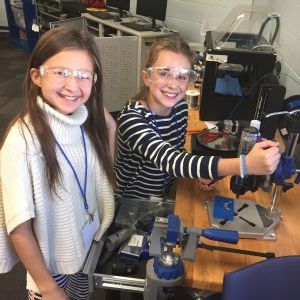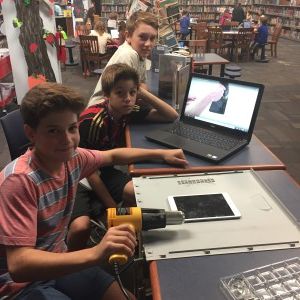Sometimes It Is Just About The Technology

We hear educators say it all the time: technology is just a tool or it’s not just about the technology, it’s about how a teacher uses it. While I fundamentally agree with these types of statements, I’ve noticed something in the Innovation Lab that has me pushing back a bit: sometimes it is just about the technology.
When we were rethinking the Innovation Lab at Fair Haven this summer and applying lessons learned from our beta year, one thing we knew we needed to address was our stuff. We didn’t have the right technology nor tools to do what we wanted to do. The tech and tools were a bottleneck for us. We had old laptops that couldn’t do things like edit videos, make games, or produce 3D renderings. Recording digital arts was harder than it had to be because we were using older camcorders with SD cards and didn’t have microphones for podcasting. Kids were forced to animate with a mouse instead of drawing tablet. We didn’t have the right tools to deconstruct iPads and other electronics and turn them into works of art. You get the idea.
As we targeted the technology we needed in the Innovation Lab for students to learn the skills we wanted them to, we started to realize that we were targeting some serious stuff. We grew hesitant. Could 5th and 6th graders handle the stuff we wanted to put in the Lab? Would they respect the tech and tools we were going to buy? One of the rules I try to live by as an educator is to make my decisions based on my best kids. Of course I could think of some incidents where I was unhappy with the respect kids were showing toward our stuff in the Lab last year, but I also thought of our kids who would flourish with better technology and tools. We pulled the trigger and bought the good stuff; we would manage the exceptions instead of making them the rule.

We made the right decision. The difference in the way our students treat the technology in the Innovation Lab this year compared to last year is night and day. Not once this year, have we had to talk to a student about how they were treating the technology. For example, through our partnership with Dell, we got top-of-the-line laptops. Our Innovators hold these laptops with two hands and walk them to their workstations. They know they share the laptops with other students throughout the week, so kids do their best to make sure the laptop is in good shape for their peers. They don’t tap to hard on the touchscreen and they shut down the computers the right way, rather than just hitting the power button. Get this: at the end of Innovation Lab students put the laptops back into the correct, numbered slots in the cart and most of the time – most of the time – they plug them in!
I also see their respect in the way students regard our stuff as well. A student accidentally broke off a piece of a laptop. This was more of a design flaw than him being careless, but to his credit he came right over, told us about it, and apologized. We thanked him for his honesty and discussed the design flaw with him.
They’re careful, too. We added a workstation where students can cut, drill, glue, or solder pieces of old technology which they then turn into pieces of art. Students have been great in making sure they get me or Ms. Smith before they start. They always follow the safety procedures and wear their safety gear. We use a heat gun, which contrary to many students’ beliefs is not a hair dryer, to lift glass off of iStuff. Students have been very careful with this, too. We were hesitant to add the heat gun, but since we did, we have had students successfully remove broken iGlass for the first time. This wasn’t possible last year. If we had given into our fears when buying our stuff, learning experiences like this would have never happened. We have a Glowforge coming and hope to do some serious soldering soon. Once upon a time, we were nervous about this. Now, we’re excited by it.

Students attitudes are different, too. More than once I’ve had students tell me or overheard them say to each other how serious the technology in the Lab is and how that must mean this is a serious program or how they are taking their making “extra serious” because of the equipment they have access to. I even see our kids self-policing. They remind each other how they should be treating the stuff in the Innovation Lab.
Tech & Learning Newsletter
Tools and ideas to transform education. Sign up below.
There was a time over the summer where we debated only putting Chromebooks in the Innovation Lab. We even made a list of the not-as-good browser versions of design tools we could use with them, but we decided we didn’t want to our kids to only have access to Tinkercad. We wanted them to be able to use Fusion360, too. We didn’t want them to just use Scratch to make a game. We wanted them to be able to build in Unity like the professionals if they wanted to. That’s what this is about, not putting a ceiling on possibilities.
Don’t get me wrong, stuff still ends up on the floor. Kids still need to be reminded it’s a screw driver and not a pry bar sometimes. Tools don’t always get put away in the right drawer, but they are getting put back in the right tool chest now! Our kids are working harder, completing more projects, and taking their learning more seriously just because we bought them the good stuff. What we’ve affirmed comes down to this: make decisions based on your best kids and don’t be afraid to buy them the good stuff. The good stuff has had a profound effect on students’ attitudes and productivity compared to last year. If we had given into our fears or fretted about their age, our students wouldn’t be half as productive as they have been this year and would have been exposed to even less.

At times we want to underestimate our students and what they are capable of. Don’t. They can do it. They deserve the good stuff.
cross-posted at Teched Up Teacher
Chris Aviles presents on education topics including gamification, technology integration, BYOD, blended learning, and the flipped classroom. Read more at Teched Up Teacher.
Chris Aviles is a STEM teacher, edtech specialist, and president of Garden State Esports. He is also a regular contributor to Tech & Learning.











